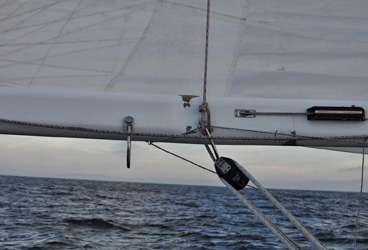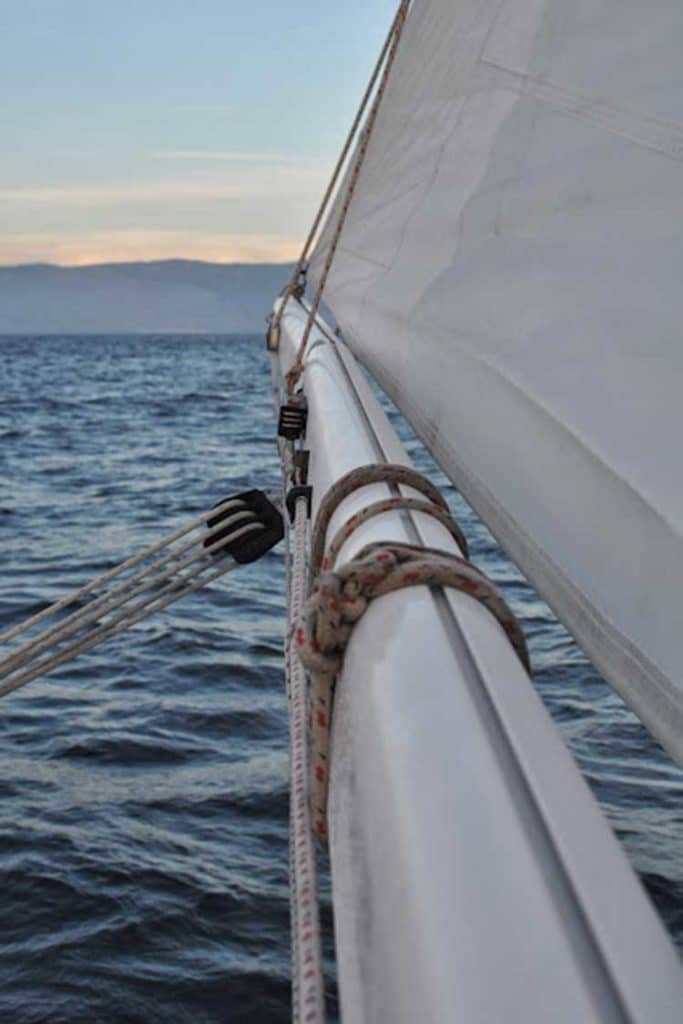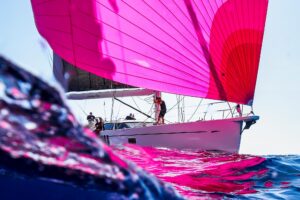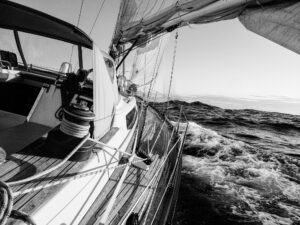
We left Tomales Bay, just north of San Francisco, for an overnight passage south. Thick, early morning fog hung low when we weighed anchor and the ocean forecast of strong winds and big seas seemed impossibly distant. Ninety minutes later, we reached the bar at the mouth of the inlet, pitching in the swells and threading our way through breakers on either side. We motored out at five knots, rolling in the beam seas until we reached Point Reyes and could turn left to head down the California Coast.
Del Viento is a pure sloop; her mast is far forward and her boom is relatively long. By late morning the engine was off and we were sailing downwind, 15 knots blowing from astern, our big main all the way out forward, just resting on the aft shrouds. Whitecaps were multiplying and we began to yaw and roll as the seas grew. Steering a heading that kept us on course, the wind was just off our port quarter, but not to far from dead downwind.
And though this heading left us only a few degrees away from a jibe, our autopilot was set to steer according to the wind and we had our preventer rigged (a 3/8” line running from a bale near the end of the boom to a snatch block secured to our bow cleat to a block on our deck to a cockpit winch). We acknowledged the risk of an unintended jibe, but reasoned that with one of us always near the helm, the event would be manageable. In 15 knots out of the northwest, the apparent wind from astern never rose above 10. If we jibed, the preventer would hold the boom to starboard while one of us would shut off the autopilot and quickly steer us back on course. We moved along comfortably at a good clip.
(You know where this is going, don’t you?)
By late afternoon, the wind and seas had increased as forecast. We sailed at just over seven knots and our indicated apparent wind had climbed to between 22 and 27 knots. The seas had grown considerably and caused us to yaw by greater degrees. We made small changes in our heading so that we could maintain our course, walking the line to prevent a jibe. But we were still comfortable, the warm sun was shining, and from 10 miles offshore, we could see the Golden Gate Bridge aft of our beam. As they say, life was good.
Del Viento lifted on a big swell. A big gust blew. The sail slacked for a brief moment and I could feel the stern falling exactly the wrong way. Before I could react the main filled with the speed of an automobile airbag and sent the boom flying across the cockpit in a blur. Then BANG! and the boat shuddered and rolled over hard on the opposite tack. I shut off the autopilot and grabbed the wheel as we accelerated into the wind. I countered to keep Del Viento running downwind, the wind now crossing our transom deep into the starboard quarter. I saw that the preventer line was still intact, stretched bar-tight across the starboard stays. I uncleated the line and eased it off the winch to spill the tension—all the while careful to make sure we didn’t jibe again.
My eyes met Windy’s and I could see she felt the same way I did.
“Can you quickly ease the traveler over to port?”
“Yeah.”
Then I saw the damage. An inch forward of the bale to which the preventer was attached, large pieces of thick, shiny, brittle white paint had fallen off the boom where it was creased in about a five- to ten-degree bend.
What were we thinking? We’ve been sailing too long together not to have thought to reef before we were in a gale. We both felt sick that we’d let this happen, that we’d damaged our boat in circumstances that were so preventable, that we’d relied so heavily on a preventer—especially because a preventer isn’t intended to prevent in over-canvased conditions.
We just messed up.

- We should have reefed.
- We shouldn’t have tried to push it, sailing on the verge of a jibe to make a better heading for our destination. In smaller seas we could have pulled this off, but being pushed around as we were, we should have increased our margin of safety by sailing on the beam side of a broad reach.
We got lucky too, as the force of this jibe could have caused more damage. We were aware enough of the risk of jibing to not have let anybody be in the path of the boom, but we didn’t do our rig any favors.
Just a bad situation overall and another lesson learned in as many months. I offer this story so that anyone else who needs can benefit in the same way, without bending their boom.
We plan to continue down to Mexico as we are, but we’ve abandoned the preventer in favor of a brake we have that attaches just aft of the vang. Our plan is to have the boom cut and sleeved or otherwise reinforced in Mexico. (And I assume this is the best approach, any advice is welcome.)
–MR
In our twenties, we traded our boat for a house and our freedom for careers. In our thirties, we slumbered through the American dream. In our forties, we woke and traded our house for a boat and our careers for freedom. And here we are. Follow along at http://www.logofdelviento.blogspot.com/








